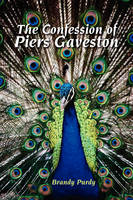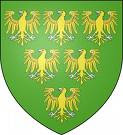Before reading this part of the blog, you may wish to read a full narrative of the life of Piers. You can find an excellent one on Alianore’s Edward II blog.
http://edwardthesecond.blogspot.com/2007/02/notorious-royal-favourite-piers.htmlI intend to comment on events/people in the life of Piers' in later posts.
If you ever read a book or article about Edward and Piers, there is one quote sure to appear –
"I do not remember to have heard that one man so loved another. Jonathan cherished David, Achilles loved Patroclus. But we do not read that they were immoderate. Our King, however, was incapable of moderate favour, and on account of Piers was said to forget himself, and so Piers was accounted a sorcerer." (Vita Edwardi Secundi)
Both the relationships between the Biblical Jonathan and David and the classical Achilles and Patroclus have been viewed as homosexual, and this quote has been used as ‘proof’ that Edward and Piers were lovers. Personally, I find it striking that the author of Vita would mention both those relationships to describe the relationship between Edward and Piers. The chroniclers of the time would have found it very difficult to discuss the sexuality of the king. In the recent BBC 4 documentaries on ‘The Medieval Mind’, homosexuality, and the act of sodomy, seems to have been the ultimate taboo. The rich and powerful were often destroyed through being accused of sodomy and witchcraft. Hell awaited them, and images of sodomites with roasting spits inserted through their anus and turned by demons were typical of the time (sound familiar?). No one accused Piers of sodomy in his lifetime and Edward was only accused in 1326, after his deposition. Whatever the depth of feeling between Edward and Piers, I doubt they would have openly flaunted their relationship to the extent it would be openly commented on. Hence the chroniclers can only subtly hint at the relationship. So we have the descriptive comparisons with David/Jonathan, Achilles/ Patroclus, and the accusation that Edward ‘forgot’ himself and Piers accused of sorcery (in another chronicle, Edward is said to love an ‘evil, male sorcerer’.)
In 1307, Edward Ist banished Piers Gaveston , seemingly because he and Prince Edward had become too close. It seems the prince had asked his father for Ponthieu for his friend. Or rather, he sent the king’s Treasurer, Walter Langton to ask. Edward 1st allegedly replied "'You wretched son of a whore! Do you want to give away lands now? You who have never gained any? As God lives, if not for fear of breaking up the Kingdom, I would never let you enjoy your inheritance!' This was followed up by a physical attack on the Prince.
The fury felt by the king seems to have been directed more at the prince than Piers, who was banished with an annual salary from the king and gifts of money and clothes from the Prince. Why should the king be so concerned about a relationship between his son and Piers? If he felt Piers was avaricious and manipulative of the prince, then why not banish him immediately and why give him a salary? It seems to me that the king may have thought the prince had some sort of ‘adolescent crush’ on Piers, and that by removing him from the Prince’s company, the ‘crush’ would be forgotten. The king’s plan didn’t work, because the new king’s first act was to recall Piers.
Edward II made Piers Earl of Cornwall, married him to his niece Margaret de Clare and showered gifts upon him. Edward would surely want to give gifts to his lover, and raise him as high as possible. Marrying him to his niece would be a further way to honour Piers and bind them together through a blood relationship. Both Edward and Piers fathered children before their marriages and also had children by their wives. It’s obvious that neither found women abhorrent and were able to have sexual relationships with women. Both men would have wanted to provide heirs, and in Edward’s case, he knew what his duty was. His relationship with Piers was no threat to his wife, Isabella of France, and didn’t prevent him from doing his duty.
Piers played a prominent part in the coronation of Edward and Isabella – even wearing royal purple. He carried the crown and organised the banquet. He had even served as regent – unopposed by the barons – when Edward had sailed for France to marry Isabella. There’s no doubt that Edward trusted him completely and wanted to honour Piers as much as he could. Was it also an attempt to show Piers he was still as important to him even though he was married?
Piers was banished twice more – with the barons using him as leverage against the king. Edward was utterly devoted to him, and could not bear to be parted from him – so much so that he made concessions to the barons to do everything he could to keep Piers with him. Is this the action of a friend or a lover?
After the third banishment, Piers returned, possibly because his wife was due to give birth and because he did not want to be parted from Edward. Without going into a full narrative account at this point, Edward and Piers were separated and Piers’ fell into the hands of his nemesis, Guy, Earl of Warwick, who took him to Warwick Castle, gave him the pretence of a trial and passed sentence of execution, in reality, murder.
That the barons were opposed to Piers, there is no doubt. The problems between Piers and the barons, I shall save for a further blog – but what strikes me about Piers’ murder is the desire by the barons to strike at the king and hurt him in the only way they could – to kill the man he loved. Whatever Piers was accused of, he didn’t deserve to die. Did the barons, like the king’s father before them, think of Piers’ influence as unnatural, and to blame for all the woes that had befallen the country? Did they, in their ‘medieval minds’, think by removing Piers the king’s passion would die, and their jealousies over intimacy, titles and lands would be allayed?
Edward was devastated – and it is his treatment of Piers in death that also convinces me they had been lovers. Edward had a strong affinity to the Dominican friars, and he brought Piers’ body to the friary at Langley. The Dominican friars had the head sewn back and the body embalmed. Edward worked tirelessly to have the excommunication passed on Piers reversed, and even when this was done, it was a further two years before Piers was buried. Why did Edward wait so long before burying Piers’ body? Possibly because he could not bear to place his body in the ground. Edward ordered that prayers were said for the soul of Piers, and he never forgot the treachery of the barons. The execution of his cousin, Thomas of Lancaster, in many ways was a ‘parody’ of Piers’. Edward also made frequent references to Piers throughout the remainder of his reign.









